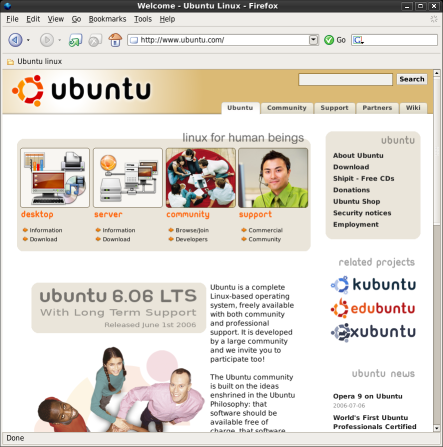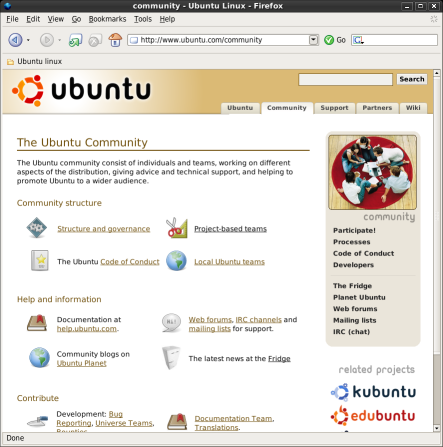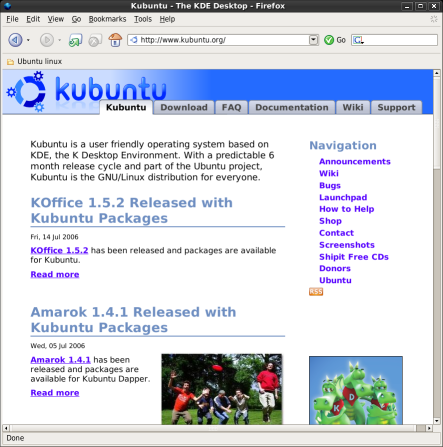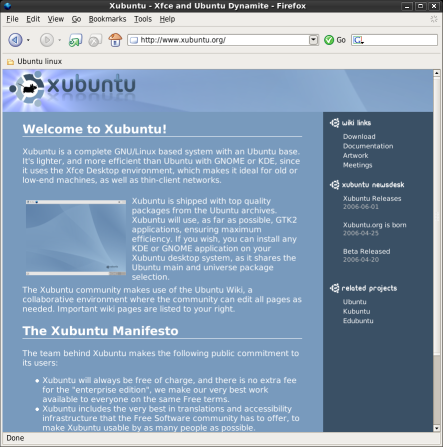UnifiedUbuntuBranding
|
Size: 5137
Comment:
|
← Revision 47 as of 2008-08-06 16:22:03 ⇥
Size: 9754
Comment: converted to 1.6 markup
|
| Deletions are marked like this. | Additions are marked like this. |
| Line 1: | Line 1: |
| ||<tablestyle="width: 100%" style="text-align: left; border:0;">attachment:spec-071861.png||<style="text-align: right; border:0;">attachment:logo-071861.png|| | ||<tablestyle="width: 100%" style="text-align: left; border:0; padding-top:20px;">{{attachment:wikiLogo-072561.png}}|| ||<style="text-align: left; border:0; padding-left:160px;">Proposal Specification|| ## --------------------------------------------------------------- ## Ubuntu wikiProSpec ## Project: Unified Ubuntu Branding ## Owner: jBaer ## --------------------------------------------------------------- == A. Summary == Product definition in an open source environment is challenging. Everything is bid and acceptance is voluntary. In the truest sense of Darwinism products live and die by the activity of their development, acceptance by the user population, or the lack thereof. Distributions are built like Lego's where communities assemble finished products from a grab bag of kernels which include Linux, BSD, or Solaris and dress them in user interfaces called Gnome, KDE, and XFCE. The final product is cloned and engineered for platforms such as Intel-32, Intel-64, AMD, and PPC. As a testimony to the success of the Ubuntu community, their products have risen to a level where others are leveraging them into their own product lines. All of these nuances and permutations add to the confusion and marketing chaos. The world of Ubuntu is really a community which supports various products based on the Linux kernel. It's name sake product is a Linux kernel tailored with a Gnome user interface. Sibling products have evolved supporting the same kernel but different interfaces. In addition, specialty products have risen to support the education and server markets. The community is always in motion, the mix constantly changing and evolving, resulting in the unclear branding of Ubuntu Products. == B. Rationale == === B.1 Background === Ubuntu is a Community of people (referred to as “Community”) and a special blend of Linux mated to the Gnome Desktop (referred to as “Ubuntu Desktop”). Although Kubuntu and Xubuntu are branded in a manner which segregates them from the others, to the new user it may be unclear that Kubuntu is really Ubuntu Linux mated to the KDE Desktop and Xubuntu is really Ubuntu Linux mated to the XFCE Desktop. In addition, branding for Ubuntu Server is absent and the new user may not understand Edubuntu is really the Ubuntu Desktop targeted toward schools and young children. When we communicate the identity of Ubuntu products it is important the message is received intact and unblemished. In addition, the message must be succinct and delivered without reams of explanation. Failure to obtain these goals will alienate individuals who would otherwise be willing try the Ubuntu Desktop, Kubuntu, Xubuntu, Edubuntu, or Ubuntu Linux Server (collectively referred to as “Ubuntu Product”). As the desire of the community is to promote Ubuntu to a wider audience achieving this level of excellence is critical. === B.2 Current Branding Norms === The current branding norms for computer software is as follows. '''Owner''' -> '''Product''' -> ''Category'' -> ''Subcategory''<<BR>> ''Successful software brands:''<<BR>> Microsoft -> Windows -> XP<<BR>> Oracle -> Database -> 10g<<BR>> Apple -> Mac -> OSX<<BR>> ~-Note: Microsoft, Oracle, and Apple are registered brand names.-~ ''Applying this pattern to Ubuntu produces the following:''<<BR>> Ubuntu -> Linux -> Gnome Desktop<<BR>> Ubuntu -> Linux -> Gnome Desktop -> Education<<BR>> Ubuntu -> Linux -> KDE Desktop<<BR>> Ubuntu -> Linux -> XFCE Desktop<<BR>> Ubuntu -> Linux -> Server<<BR>> === B.3 Current branding is discriminatory === The very fact ''Ubuntu'' refers to the Community and to the Ubuntu Desktop delivers the message the Ubuntu Desktop is the preferred product. The truth is every Ubuntu Product stands on equal footing and should be presented without prejudice. === B.4 Consistent definition lacking === The Ubuntu Desktop, Kubuntu, Xubuntu, and Edubuntu fail to deliver an accurate and consistent message describing their identity. An individual from the US may interpret the Edubuntu branding correctly and then mistakenly assume Kubuntu is directed toward K12 schools. To the highest degree possible the branding should be culture agnostic. === B.5 Logo synchronization === The Kubuntu and Xubuntu logos do an excellent job blending with the Community logo. However, what is the message? Does Kubuntu coexist harmoniously with the Ubuntu Desktop, or complete against it? == C. Use cases == === The Hector Quintero Story === In the chaos which often occurs at the end of a school day, Hector Quintero hung with his friends and talked of the events of the day and other things that came to mind. <<BR>><<BR>> “I've switched my computer to Ubuntu”, boasts a friend, “and it is way cool”. <<BR>><<BR>> Interrupted by the unexpected arrival of the bus, the crowd begins to disperse and the small talk closes with an abrupt final comment. <<BR>><<BR>> “Hector, you should check it out!” <<BR>><<BR>> Hector spends a lot time at his PC doing school work and playing games. This Saturday was game day and he was taking a break from a difficult battle scene when he remembered the words of his friend and directs his browser toward the Ubuntu home page. Greeted by smiling faces, he is pleased by the clean professional look and his enthusiasm builds as he peers through the details. <<BR>><<BR>> Standing out like the head lines of a daily news paper the words “ubuntu”, “kubuntu”, “xubuntu” catch his attention and spike his curiosity. <<BR>><<BR>> “What is this all about?” he questions as he moves closer to his screen. <<BR>><<BR>> “Ubuntu is a complete Linux-based operating system ...” states the commentary. <<BR>><<BR>> “Linux, wow ... I've heard of that!” he responds. <<BR>><<BR>> Driven again by curiosity he clicks the community link. <<BR>><<BR>> “The Ubuntu community consist of individuals and teams ...” the editorial begins. <<BR>><<BR>> With a puzzle look he leans back in his chair to consider the meaning of that statement. <<BR>><<BR>> “I thought Ubuntu referred to the OS, not a group of people?" he murmurs. <<BR>><<BR>> Returning to the keyboard with a more distant posture, his eyes engage the screen, his mouse the kubuntu link. <<BR>><<BR>> “Kubuntu is a user friendly operating system based on KDE, the K Desktop Environment ...” begins the opening sentence. <<BR>><<BR>> “Now I am really confused, I thought Linux was the OS!” states Hector. <<BR>><<BR>> Fueled by his frustration the pace quickens as he navigates to the xubuntu page and not really sure of what to expect he begins reading below the headline. <<BR>><<BR>> "Xubuntu is a complete GNU/Linux based system with an Ubuntu base ....” <<BR>><<BR>> At this point the sounds bites and the head lines have run together blurring their definition and a frustrated Hector grumbles, “and what is an Ubuntu base?” <<BR>><<BR>> Pausing to reflect on the answer he chuckles with the response. <<BR>><<BR>> “Too much like home work!” <<BR>> |
| Line 5: | Line 111: |
| {{{ This page is under development, please do not edit. }}} ##(see the SpecSpec for an explanation) ## Register at https://launchpad.net/distros/ubuntu/+specs * '''Launchpad entry''': none yet * '''Created''': [[Date(2006-07-18T16:49:14Z)]] by jBaer * '''Contributors''': jBaer * '''Packages affected''': Ubuntu, Kubuntu, Xubuntu, Edubuntu, Ubuntu Server == A. Summary == The clear identification of Ubuntu Products is lacking. Ubuntu refers to the Ubuntu Community (referred to as “Community”) and to Ubuntu Linux – Gnome Desktop (referred to as “Desktop”). Although Kubuntu and Xubuntu are branded in such a manner as to segregate them from the other products, to the new user it may be unclear that Kubuntu is really Ubuntu Linux – KDE Desktop and Xubuntu is really Ubuntu Linux – XFCE Desktop. In addition, branding for Ubuntu Linux Server is absent and the new user may not understand Edubuntu is really the Desktop targeted to schools and young children. == B. Rationale == As we develop new products for the Ubuntu community, it's important to communicate their identity unblemished. When discussing current products it's important to clearly communicate their identity without paragraphs of explanation. Failure to deliver the correct message will alienate individuals who would otherwise try the Desktop, Kubuntu, Xubuntu, Edubuntu, or Ubuntu Linux Server (collectively referred to as “Ubuntu Product”). The desire of the community is to encourage people to use Ubuntu Products and the current branding constrains that desire. === B.1 Current branding is discriminatory === The very fact Ubuntu refers to the Community and to the Desktop delivers the message the Desktop is the preferred Ubuntu Product. The truth is every Ubuntu Product stands on equal footing and should be presented without prejudice. === B.2 Consistant definition lacking === The Desktop, Kubuntu, and Xubuntu fail to deliver an accurate and consistant message describing their identity. === B.3 Logo synchronization === The Kubuntu and Xubuntu logos do an excellent job establishing a harmonious identity within the Ubuntu framework. The Desktop is without a logo and is forced to use the Community logo. == C. Use cases == === 1st Time to Ubuntu Web Site === Hector overheard from his school friends bragging Ubuntu is ''way cool... better than the other junk''. Deciding to check it out he boots his current OS, journeys to the Ubuntu home page, and is greeted by smiling faces. His eyes are drawn to the large Ubuntu logo and then to the words kubuntu, xubuntu, and edubuntu highlighted under a title scribed ''related projects''. [[BR]][[BR]] Continuing, his gaze drifts toward the center. [[BR]][[BR]] ''“Ubuntu is a complete Linux-based operating system, freely available with both community and professional support. It is developed by a large community and we invite you to participate too!”'' [[BR]][[BR]] “Interesting, developed by a community”, he comments to himself. [[BR]][[BR]] Curious, he clicks the community icon, waits for the page to load, and continues. [[BR]][[BR]] ''“The Ubuntu community consist of individuals and teams, working on different aspects of the distribution, giving advice and technical support, and helping to promote Ubuntu to a wider audience.”'' [[BR]][[BR]] Randomly his mind questions, “Ubuntu community? Is a community the same as a company? How does kubuntu fit in?” [[BR]][[BR]] Clicking the kubuntu link a new page loads and he continues his research. [[BR]][[BR]] ''“Kubuntu is a user friendly operating system based on KDE, the K Desktop Environment. With a predictable 6 month release cycle and part of the Ubuntu project, Kubuntu is the GNU/Linux distribution for everyone.”'' [[BR]][[BR]] “User friendly OS? I thought Linux was the OS”, he exclaims. [[BR]][[BR]] Clicking the back arrow the Ubuntu home page loads and he gives xubuntu a click. [[BR]][[BR]] As his eyes scan the opening sentences, his lips utter the words. [[BR]][[BR]] ''"Xubuntu is a complete GNU/Linux based system with an Ubuntu base. It's lighter, and more efficient than Ubuntu with GNOME or KDE, since it uses the Xfce Desktop environment, which makes it ideal for old or low-end machines, as well as thin-client networks."'' [[BR]][[BR]] Pausing to bring his thoughts into focus he questions, “What is a GNU/Linux... a Ubuntu base?” [[BR]][[BR]] The answer eludes his comprehension. [[BR]][[BR]] "Too much like work" he concludes as he shuts down his browser and pushes away from his desk. [[BR]] |
||<tablestyle="width: 100%" style="text-align: center; border:0;">{{attachment:webSite01.png}}||<style="text-align: center; border:0;">{{attachment:webSite02.png}}|| ||<style="text-align: center; border:0;">{{attachment:webSite03.png}}||<style="text-align: center; border:0;">{{attachment:webSite04.png}}|| ||||<style="text-align: center; border:0;">~-Ubuntu Internet Site-~|| ||||<style="text-align: center; border:0;">~-The Hector Quintero Story-~|| |
| Line 76: | Line 118: |
| * Re-brand Ubuntu Linux Gnome Desktop * Re-brand Ubuntu Linux KDE Desktop * Re-brand Ubuntu Linux XFCE Desktop * Re-brand Ubuntu Linux Server Edition * Re-brand Ubuntu Linux Education Edition |
|
| Line 77: | Line 125: |
==== Scenario # 1 ==== Retain the branding of current products to the highest possible degree. ''To illustrate ...'' 32bit Ubuntu becomes Ubuntu Linux Gnome Desktop - 32bit<<BR>> {{attachment:Ubuntu-gOS-072661.png}} 64bit Kubuntu becomes Ubuntu Linux KDE Desktop - 64bit<<BR>> {{attachment:Ubuntu-kOS-072661.png}} ==== Scenario # 2 ==== Re-brand all products to a new unified structure ''To illustrate ...'' 32bit Ubuntu becomes Ubuntu Linux /g32<<BR>> {{attachment:Ubuntu-gOS-072662.png}} 64bit Kubuntu becomes Ubuntu Linux /k64<<BR>> {{attachment:Ubuntu-kOS-072662.png}} ~-Note: Scenario 1 & 2 are strictly to illustrate the point with the final decision<<BR>> and brand name to be determined as a deliverable of this project.-~ |
|
| Line 80: | Line 159: |
| == G. Unresolved issues == | * Create an unified branding template for all products * Apply template to the current products * Create artwork to reflect new branding, if required * Create rollout campaign, press releases, etc. |
| Line 82: | Line 164: |
| == H. BoF agenda and discussion == | == G. Obstacles/Unresolved issues == |
| Line 84: | Line 166: |
| [[BR]] ||<tablestyle="width: 100%" style="text-align: center; border:0; width:40px;">attachment:folder.png||<style="text-align: left; border:0;">Doc Version: 071861|| |
1. Each product team has been involved in the branding of their respected products and there is substantial momentum in the current branding. The constituency of these teams will need to agree and endorse the change. 2. The process needs to be mindful of edeavors past and present. There may be Community endorsed initiatives at play which re-branding may harm. * Ubuntu Book * Distro Watch == H. References == === H.1 Project Charter === [[https://wiki.ubuntu.com/UnifiedUbuntuBrandingCharter]] === H.2 Launchpad Specification === Pending == I. BoF agenda and discussion == Pending <<BR>> ||<tablestyle="width: 100%" style="text-align: center; border:0; width:40px;">{{attachment:folder.png}}||<style="text-align: left; border:0;">Doc Version: 072661|| |
|
Proposal Specification |
A. Summary
Product definition in an open source environment is challenging. Everything is bid and acceptance is voluntary. In the truest sense of Darwinism products live and die by the activity of their development, acceptance by the user population, or the lack thereof.
Distributions are built like Lego's where communities assemble finished products from a grab bag of kernels which include Linux, BSD, or Solaris and dress them in user interfaces called Gnome, KDE, and XFCE. The final product is cloned and engineered for platforms such as Intel-32, Intel-64, AMD, and PPC. As a testimony to the success of the Ubuntu community, their products have risen to a level where others are leveraging them into their own product lines.
All of these nuances and permutations add to the confusion and marketing chaos.
The world of Ubuntu is really a community which supports various products based on the Linux kernel. It's name sake product is a Linux kernel tailored with a Gnome user interface. Sibling products have evolved supporting the same kernel but different interfaces. In addition, specialty products have risen to support the education and server markets. The community is always in motion, the mix constantly changing and evolving, resulting in the unclear branding of Ubuntu Products.
B. Rationale
B.1 Background
Ubuntu is a Community of people (referred to as “Community”) and a special blend of Linux mated to the Gnome Desktop (referred to as “Ubuntu Desktop”). Although Kubuntu and Xubuntu are branded in a manner which segregates them from the others, to the new user it may be unclear that Kubuntu is really Ubuntu Linux mated to the KDE Desktop and Xubuntu is really Ubuntu Linux mated to the XFCE Desktop. In addition, branding for Ubuntu Server is absent and the new user may not understand Edubuntu is really the Ubuntu Desktop targeted toward schools and young children.
When we communicate the identity of Ubuntu products it is important the message is received intact and unblemished. In addition, the message must be succinct and delivered without reams of explanation. Failure to obtain these goals will alienate individuals who would otherwise be willing try the Ubuntu Desktop, Kubuntu, Xubuntu, Edubuntu, or Ubuntu Linux Server (collectively referred to as “Ubuntu Product”). As the desire of the community is to promote Ubuntu to a wider audience achieving this level of excellence is critical.
B.2 Current Branding Norms
The current branding norms for computer software is as follows.
Owner -> Product -> Category -> Subcategory
Successful software brands:
Microsoft -> Windows -> XP
Oracle -> Database -> 10g
Apple -> Mac -> OSX
Note: Microsoft, Oracle, and Apple are registered brand names.
Applying this pattern to Ubuntu produces the following:
Ubuntu -> Linux -> Gnome Desktop
Ubuntu -> Linux -> Gnome Desktop -> Education
Ubuntu -> Linux -> KDE Desktop
Ubuntu -> Linux -> XFCE Desktop
Ubuntu -> Linux -> Server
B.3 Current branding is discriminatory
The very fact Ubuntu refers to the Community and to the Ubuntu Desktop delivers the message the Ubuntu Desktop is the preferred product. The truth is every Ubuntu Product stands on equal footing and should be presented without prejudice.
B.4 Consistent definition lacking
The Ubuntu Desktop, Kubuntu, Xubuntu, and Edubuntu fail to deliver an accurate and consistent message describing their identity. An individual from the US may interpret the Edubuntu branding correctly and then mistakenly assume Kubuntu is directed toward K12 schools. To the highest degree possible the branding should be culture agnostic.
B.5 Logo synchronization
The Kubuntu and Xubuntu logos do an excellent job blending with the Community logo. However, what is the message? Does Kubuntu coexist harmoniously with the Ubuntu Desktop, or complete against it?
C. Use cases
The Hector Quintero Story
In the chaos which often occurs at the end of a school day, Hector Quintero hung with his friends and talked of the events of the day and other things that came to mind.
“I've switched my computer to Ubuntu”, boasts a friend, “and it is way cool”.
Interrupted by the unexpected arrival of the bus, the crowd begins to disperse and the small talk closes with an abrupt final comment.
“Hector, you should check it out!”
Hector spends a lot time at his PC doing school work and playing games. This Saturday was game day and he was taking a break from a difficult battle scene when he remembered the words of his friend and directs his browser toward the Ubuntu home page. Greeted by smiling faces, he is pleased by the clean professional look and his enthusiasm builds as he peers through the details.
Standing out like the head lines of a daily news paper the words “ubuntu”, “kubuntu”, “xubuntu” catch his attention and spike his curiosity.
“What is this all about?” he questions as he moves closer to his screen.
“Ubuntu is a complete Linux-based operating system ...” states the commentary.
“Linux, wow ... I've heard of that!” he responds.
Driven again by curiosity he clicks the community link.
“The Ubuntu community consist of individuals and teams ...” the editorial begins.
With a puzzle look he leans back in his chair to consider the meaning of that statement.
“I thought Ubuntu referred to the OS, not a group of people?" he murmurs.
Returning to the keyboard with a more distant posture, his eyes engage the screen, his mouse the kubuntu link.
“Kubuntu is a user friendly operating system based on KDE, the K Desktop Environment ...” begins the opening sentence.
“Now I am really confused, I thought Linux was the OS!” states Hector.
Fueled by his frustration the pace quickens as he navigates to the xubuntu page and not really sure of what to expect he begins reading below the headline.
"Xubuntu is a complete GNU/Linux based system with an Ubuntu base ....”
At this point the sounds bites and the head lines have run together blurring their definition and a frustrated Hector grumbles, “and what is an Ubuntu base?”
Pausing to reflect on the answer he chuckles with the response.
“Too much like home work!”
|
|
|
|
Ubuntu Internet Site |
|
The Hector Quintero Story |
|
D. Scope
- Re-brand Ubuntu Linux Gnome Desktop
- Re-brand Ubuntu Linux KDE Desktop
- Re-brand Ubuntu Linux XFCE Desktop
- Re-brand Ubuntu Linux Server Edition
- Re-brand Ubuntu Linux Education Edition
E. Design
Scenario # 1
Retain the branding of current products to the highest possible degree.
To illustrate ...
32bit Ubuntu becomes Ubuntu Linux Gnome Desktop - 32bit

64bit Kubuntu becomes Ubuntu Linux KDE Desktop - 64bit

Scenario # 2
Re-brand all products to a new unified structure
To illustrate ...
32bit Ubuntu becomes Ubuntu Linux /g32

64bit Kubuntu becomes Ubuntu Linux /k64

Note: Scenario 1 & 2 are strictly to illustrate the point with the final decision
and brand name to be determined as a deliverable of this project.
F. Implementation
- Create an unified branding template for all products
- Apply template to the current products
- Create artwork to reflect new branding, if required
- Create rollout campaign, press releases, etc.
G. Obstacles/Unresolved issues
- Each product team has been involved in the branding of their respected products and there is substantial momentum in the current branding. The constituency of these teams will need to agree and endorse the change.
- The process needs to be mindful of edeavors past and present. There may be Community endorsed initiatives at play which re-branding may harm.
- Ubuntu Book
- Distro Watch
H. References
H.1 Project Charter
https://wiki.ubuntu.com/UnifiedUbuntuBrandingCharter
H.2 Launchpad Specification
Pending
I. BoF agenda and discussion
Pending
|
Doc Version: 072661 |
UnifiedUbuntuBranding (last edited 2008-08-06 16:22:03 by localhost)





